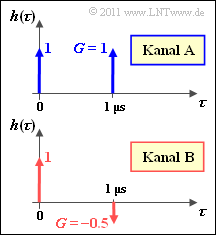Exercise 2.7Z: Coherence Bandwidth of the LTI Two-Path Channel
For the GWSSUS–model, two parameters are given, which both statistically capture the resulting delay $\tau$ . More information on the topic „multipath propagation” can be found in section Simulation gemäß dem GWSSUS–Modell of the theory part.
- The delay spread $T_{\rm V}$ is by definition equal to the standard deviation of the random variable $\tau$.
This can be determined from the probability density $f_{\rm V}(\tau)$ . The PDF $f_{\rm V}(\tau)$ has the same shape as the delay power density spectrum ${\it \Phi}_{\rm V}(\tau)$. - The coherence bandwidth $B_{\rm K}$ describes the same situation in the frequency domain.
This is implicitly defined by the frequency–correlation function $\varphi_{\rm F}(\delta f)$ defined as the $\delta f$–value at which its amount first dropped to half:
$$$\varphi_{\rm F}(\Delta f = B_{\rm K})| \stackrel {!}{=} {1}/{2} \cdot |\varphi_{\rm F}(\delta f = 0)| \hspace{0.05cm}.$$
The connection between ${\it \Phi}_{\rm V}(\tau)$ and $\varphi_{\rm F}(\delta f)$ is given by the Fourier transform: $$\varphi_{\rm F}(\delta f) \{\hspace{0.2cm} {\bullet\!} {\hspace{0.2cm} {\it \Phi}_{\rm V}(\tau)\hspace{0.05cm}.$ *Both definitions are only partially suitable for a time invariant channel. *Often one uses for a time invariant two-way channel (i.e. with constant path weights according to the above graphic) as an approximation for the coherence bandwidth: :$$B_{\rm K}\hspace{0.01cm}' = \frac{1}{\frac_{\rm max} - \frac_{\rm min}} \hspace{0.05cm}.$$ In this task we want to clarify * why there are different definitions for the coherence band in the literature, * which connection exists between $B_{\rm K}$ and $B_{\rm K}\hspace{0.01cm}'$ and * which definitions make sense for which boundary conditions. ''Notes:'' *This task belongs to the chapter [[Mobile_Kommunikation/Das_GWSSUS%E2%80%93Kanalmodell| Das GWSSUS–Kanalmodell]]. *This task also refers to some theory pages in chapter [[Mobile_Kommunikation/Mehrwegeempfang_beim_Mobilfunk| Mehrwegeempfang beim Mobilfunk]]. ==='"`UNIQ--h-0--QINU`"'Questionnaire=== '"`UNIQ--quiz-00000002-QINU`"' ==='"`UNIQ--h-1--QINU`"'Sample solution=== {'"`UNIQ--html-00000003-QINU`"' '''(1)''' For both channels the runtime difference is $\Delta \tau = \tau_{\rm max} \, - \tau_{\rm min} = 1 \ \ \rm µ s$. * That's why both channels have the same value: $$B_{\rm K}\hspace{0.01cm}' \ \ \underline {= 1000 \ \rm kHz}.$$ '''(2)''' The graphics refer to the impulse response $h(\tau)$. *To obtain the delay–LDS, the weights must be squared: $${\it \Phi}_{\rm V}(\tau) = 1^2 \cdot \delta(\tau) + G^2 \cdot \delta(\tau - \tau_0) \hspace{0.05cm}.$ *The integral over ${\it \Phi}_{\rm V}(\tau)$ is therefore $1 + G^2$. *The probability density function (WDF), however, must give the „area 1” (sum of the two Dirac weights equals $1$). From this follows: '"`UNIQ-MathJax35-QINU`"'m_{\rm V} = \frac{\frost_0}{2} {\hspace{0.15cm} {= 0.5\,{\rm µ s}}\hspace{0.05cm} \hspace{0.2cm}T_{\rm V} = \sigma_{\rm V} =\frac{\tau_0}{2} \hspace{0.15cm}\underline {= 0.5\,{\rm µ s} \hspace{0.05cm}.'"`UNIQ-MathJax36-QINU`"'m_{\rm 1} \hspace{-0.1cm} \ = \ \hspace{-0.1cm} 0.8 \cdot 0 + 0.2 \cdot 1\,{\rm µ s} = 0.2\,{\rm µ s} \hspace{0.05cm},\hspace{0.5cm} m_{\rm 2} \hspace{-0.1cm} \ = \ \hspace{-0.1cm} 0.8 \cdot 0^2 + 0.2 \cdot (1\,{\rm µ s})^2 = 0.2\,({\rm µ s})^2 \hspace{0.05cm}.'"`UNIQ-MathJax37-QINU`"'\sigma_{\rm V}^2 = m_{\rm 2} - m_{\rm 1}^2 = 0.2\,({\rm µ s})^2 - (0.2\,{\rm µ s})^2 = 0.16\,({\rm µ s})^2 \hspace{0.3cm}\Rightarrow \hspace{0.3cm}T_{\rm V} = \sigma_{\rm V} \hspace{0.15cm}\underline {= 0.4\,{\rm µ s}}\hspace{0.05cm}.'"`UNIQ-MathJax38-QINU`"'$\varphi_{\rm F}(\delta f) = 1 + {\rm exp}(-{\rm j} \cdot 2\pi \cdot \delta f \cdot \cdot \tau_0) = 1 + {\rm cos}(2\pi \cdot \delta f \cdot \tau_0) -{\rm j} \cdot {\rm sin}(2\pi \cdot \delta f \cdot \tau_0) $$ [[File:P_ID2186__Mob_Z_2_7d.png|right|frame|Frequency correlation function and coherence bandwidth]] $$\Rightarrow \hspace{0.3cm} |\varphi_{\rm F}(\delta f)| = \sqrt{2 + 2 \cdot {\rm cos}(2\pi \cdot \delta f \cdot \cdot \tau_0) }\hspace{0.05cm}.$ *The function maximum at $\delta f = 0$ is equal to $2$. *Therefore the equation of determination for $B_{\rm K}$ is '"`UNIQ-MathJax40-QINU`"' '"`UNIQ-MathJax41-QINU`"' '"`UNIQ-MathJax42-QINU`"' '"`UNIQ-MathJax43-QINU`"' *Correct is therefore the <u>solution 1</u>. The graphic (blue curve) illustrates the result. '''(5)''' For the channel ${\rm B}$ the corresponding equations are '"`UNIQ-MathJax44-QINU`"' '"`UNIQ-MathJax45-QINU`"' *You can see from this result that the $50\%$–coherence bandwidth cannot be specified here. *The correct solution is therefore the <u>solution proposal 4</u>. This result is the reason why there are different definitions for the coherence range in the literature, for example * the $90\%$–coherence bandwidth (in the example $B_{\rm K, \hspace{0.03cm} 90\%} =184 \ \ \rm kHz$), * the very simple approximation $B_{\rm K}\hspace{0.01cm}'$ given above (in the example $B_{\rm K}\hspace{0.01cm}' =1 \ \ \rm MHz$)
You can see from these numerical values that all the information on this is very vague and that the individual „coherence bandwidths” can differ by factors.
